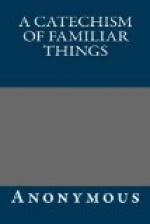[Illustration: THE SALT MINES OF WIELICZCA.]
What do you mean by Metals?
Useful substances dug from the bowels of the earth, being sometimes found pure, but mostly combined with other matter. They are distinguished by their weight, tenacity, hardness, opacity, color, and peculiar lustre, known as the metallic lustre; they are fusible by heat, and good conductors of heat and electricity; many of them are malleable, and some extremely ductile. Those which were first known are gold, silver, iron, copper, mercury, lead, and tin.
Tenacity, the
firmness with which one part adheres to
another.
Opacity, want of transparency or clearness.
What are Metals called in their natural state?
Ores; so named because the metal contained in them is either mixed with other metals, or with mineral earths, from which they are separated and purified by various means: such as washing, roasting, &c., but the method is always regulated by the nature of the ore.
What is Copper?
A hard, heavy, ductile metal, found native, and in many ores; of these the most important is copper pyrites, which is a sulphuret of copper. Next to gold, silver, and platinum, copper is the most malleable and ductile of metals; it may be drawn into wires as fine as hair, or beaten into leaves as thin as those of silver. The rust of copper is very poisonous. Copper, mixed with a certain quantity of tin, forms bell-metal. With a smaller proportion, it forms bronze, a substance used in sculpture for casting figures and statues. It is an abundant metal, and is found in various parts of the world. Native oxides of copper are found in Cornwall, Siberia, and in North and South America.
Oxide, a substance
combined with Oxygen,[8] in a
proportion not sufficient
to produce acidity.
Sulphuret, a combination of sulphur with a base.
[Footnote 8: See Chapter XIII., article Oxygen.]
What are the uses of Copper?
They are too various to be enumerated. In sheets it is much used to sheathe the bottoms of ships, for boilers, and other utensils. Copper coin was the only money used by the Romans till the 485th year of their city, when silver began to be coined. In Sweden, houses are covered with this metal.
What is a Mine?
A cavity under ground, formed for the purpose of obtaining metals, &c.; mines are often very deep and extensive. The descent into them is by a pit, called a shaft; the clues by which mines are discovered, are, mineral springs, the discoloration of vegetables, the appearance of pieces of ore, &c.
Clues, signs
or means by which things hidden are brought
to light.
What is Brass?
A factitious metal, consisting of copper and zinc. Brass is lighter and harder than pure copper, and less subject to rust; owing to these properties, together with its beautiful color, it is extremely useful in the manufacture of many utensils.




